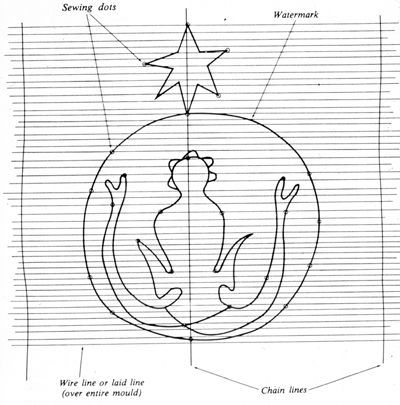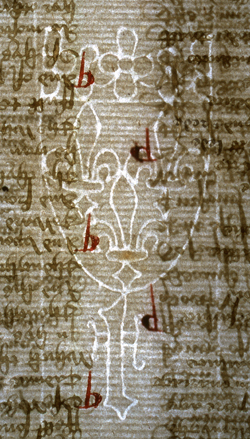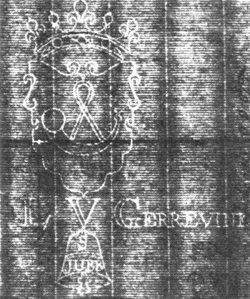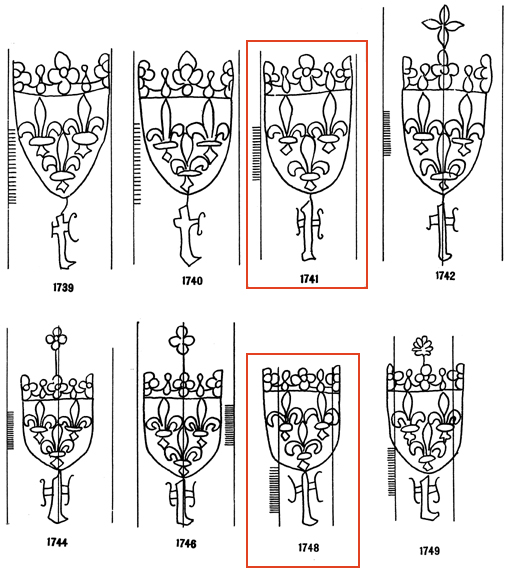Watermarks
David Badke
|
|
|
Watermarks |
|
David Badke |
Watermarks are translucent impressions on paper, created by wires attached to the papermaking mould. They were (and are) used to identify the maker of the paper, and sometimes where and when the paper was made. Watermarks were produced in a wide variety of shapes and styles, ranging from geometric designs to images of animals, flowers, national symbols (such as the fleur-de-lis of France), and words or names. The watermark wire shape was attached to the paper mould by being sewed to the laid wires (horizontal) and chain wires (vertical) with fine wire; this caused "sewing dots" to be impressed on the paper along with the watermark.

From Essays in Paper Analysis, Stephen Spector, p. 207
The combination of watermark shape, positioning on the sheet and sewing dot pattern can be used to identify the manufacturer of the paper, as well as the geographic area where it was produced and the approximate date of manufacture. There is considerable uncertainty inherent in this identification, however; watermark evidence alone can only provide clues, not precise facts. The uncertainties of watermark analysis include:
The same papermaker may have used several different watermarks.
The same mark may have been used by the same or a different papermaker at times separated by decades.
Other papermakers may have imitated a successful manufacturer’s mark.
The watermark shape changed gradually as the mould was used, and sometimes the watermark wire broke and was repaired, changing the shape.
Paper was sometimes manufactured years before it was used.
The watermark in question may not appear in any published catalog and so cannot be compared to watermarks of known papermakers.
Existing watermark catalogs (Briquet, Les Filigranes for example) were produced from tracings of watermarks, introducing considerable imprecision.
The recording of watermark images has long been problematic. Existing catalogs (such as Briquet) which use tracings do not show all of the details needed for exact identification. Tracings are also subject to human error in determining the true contours of the watermark (many of which are hidden behind text or are otherwise difficult to see) and in accurately transferring those contours to the drawing surface. Tracings also result in black lines on a white background, when watermarks consist of more translucent lines on a less translucent background. Other methods have been used, including backlit photography (as was done with the Lydgate manuscript) which produces a good image but cannot always show sufficient detail; a visible light photograph also records the text which often obscures parts of the watermark.

Watermark Type 2 (folio 8) via backlit photography.
The text from both sides of the paper obscures part of the watermark.
The current best technique, beta-radiography, involves producing an X-ray image of the paper. This is done by sandwiching the sheet of paper between a radioactive source, usually a plastic sheet impregnated with Carbon 14, and X-ray film; the X-rays pass more easily through the thinner areas of the paper (the watermark, laid lines and chain lines) and so record the paper in black and the watermark in white. The resulting image is highly detailed and clearly shows the watermark, eliminating the text and/or illustrations that may be covering it. The radioactive source is said to have no effect on the paper (Schoonover, 1987). This technique has not been tried on the Lydgate manuscript due to unavailability of the requisite materials and fear of protests from the Special Collections librarian.

Watermark image by beta-radiography
From Essays
in Paper Analysis, Stephen Spector, editor, page 167
The Lydgate manuscript paper has two distinct watermarks, arbitrarily designated Type 1 and Type 2. (The watermarks in the images below have been digitally traced from backlit photographs and enhanced for clarity.)
|
|
|
|
Type 1 |
Type 2 |
The watermarks are basically the same symbol; the difference between them is in the precise shape and position of the elements of the design. While there are only two basic watermarks found in the manuscript, there are slight variations within those types from sheet to sheet. These variations were likely caused by movement of the watermark wires on the mould and by differences in how the pulp fibers arranged themselves over the wires. The scribe who used the Lydgate paper did not make any effort to orient each sheet of paper in the same way, so on several sheets the watermark is upside down with respect to the text. To record this, the two watermark types were further divided into those right side up relative to the text (Types 1u and 2u) and those upside down relative to the text (Type 1d and 2d). The watermark on all Lydgate sheets is near the center of one half of the sheet; for Types 1u and 2u this places the watermark on the left half of the sheet, and for Types 1d and 2d this places the watermark on the right half of the sheet. The watermarks are positioned near the vertical center of the sheet as well, though a few sheets (folia 67 and 94, for example) have the watermark about 15mm lower on the page than usual. This probably indicates differences in trimming those sheets since the position of the watermark on the mould is unlikely to have changed by that much.
The symbol used for the Lydgate paper watermarks is a fairly common one, a shield or cup shape containing three connected fleur-de-lis symbols, with a series of floral shapes above and a stylized Gothic letter "T" below. The most obvious differences between Type 1 and Type 2 are found in the lower fleur-de-lis and in the letter "T"; in the Type 1 watermark the vertical leaf of the fleur-de-lis points somewhat to the right while in Type two it points somewhat to the left; letter "T" is thicker in Type 2; and the flourishes on the end of the "T" cross stroke differ markedly between Type 1 and Type 2.
The medieval process of papermaking normally required the use of two or more moulds for each batch of paper. The moulds would start out more or less identical, but would develop variations in the position of their various elements over time. The watermarks on each mould would initially be as similar as the artisan could make them, but no two shapes formed from wire could be exactly the same, so even when new the watermarks on each mold would be somewhat different. This difference can be used to determine the minimum number of moulds that were used to produce a given batch of paper; in the case of the Lydgate manuscript that minimum number is two.
Briquet lists many watermarks showing some or all of the elements found in the Lydgate watermarks; the images from Briquet number 1736 to 1761 are all composed of three fleur-de-lis symbols in a shield shape with a letter below. The chief difference in this range of Briquet images is in the shapes of the elements above the shield; these range from flowers to crowns to more fleur-de-lis symbols. Some have additional elements, usually floral, above the elements on top of the shield and attached to it by a vertical wire. Within the image 1736 to 1761 range, eight images are fairly similar to the Lydgate watermarks (images 1739, 1740, 1741, 1742, 1744, 1746, 1748 and 1749), with 1741 being the closest match and 1748 the next closest. No image in Briquet matches the Lydgate watermarks exactly, and even the closest matches have significant differences in the fleur-de-lis pattern, the floral pattern above the shield, and the shape of the letter "T" below the shield. However, the Lydgate watermarks clearly fall into the Briquet range 1739 to 1749, and from this some tentative conclusions can be drawn.

Composite
image from Les Filigranes: Dictionaire
Historique des Marques du Papier, C.M. Briquet, Volume 1,
showing the range of watermarks most closely resembling the Lydgate manuscript
watermarks.
Briquet numbers 1741 and 1748 appear to be the closest matches,
though neither are an exact match to either Lydgate watermark.
Examination of the arrangement of the images in Briquet (which are ordered based on the shape and elements of the watermarks) shows that similar watermarks generally have similar dates and places of use. The Briquet images 1739 to 1749 range in date from 1458 to 1526 and in area of use from Rouen and Paris in the south to Strasbourg in the east and Rotterdam in the north. The closest match, image 1741, is found in manuscripts dated from 1470 to 1482 in locations including Beauvais, Paris, Troyes, Strasbourg, Cologne, and Amsterdam. The next closest match, image 1748, is dated from 1509 to 1522 in locations around Caen, France. In both cases the marks were used in the region extending from northern France to the Netherlands and east to Germany, which is consistent with the known trade in paper from this area to Britain. This analysis suggests that the paper used in the Lydgate manuscript was manufactured in Normandy or the nearby region sometime between 1470 and 1509, with a date in the 1480’s being likely. It must be emphasized that this location and date of manufacture is uncertain; further evidence and analysis would be required to confirm both the date and location.